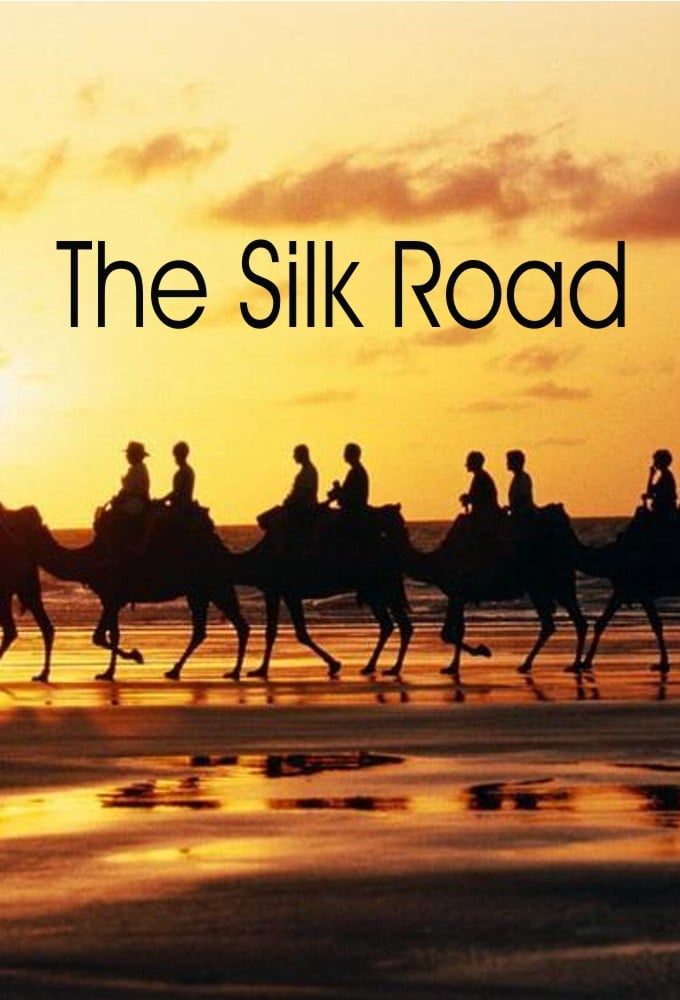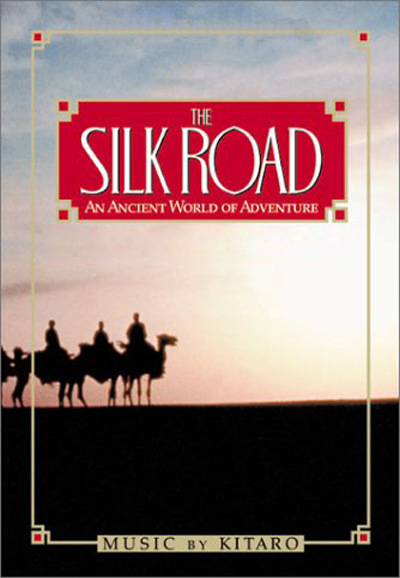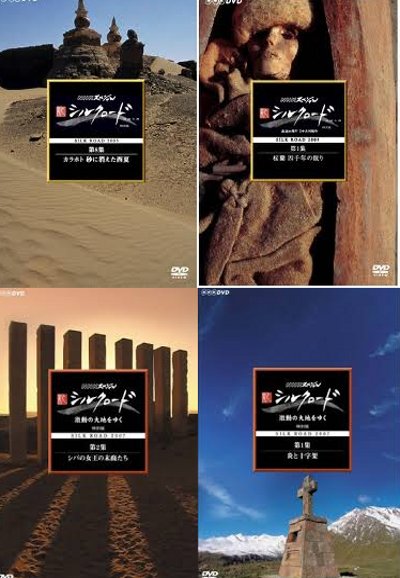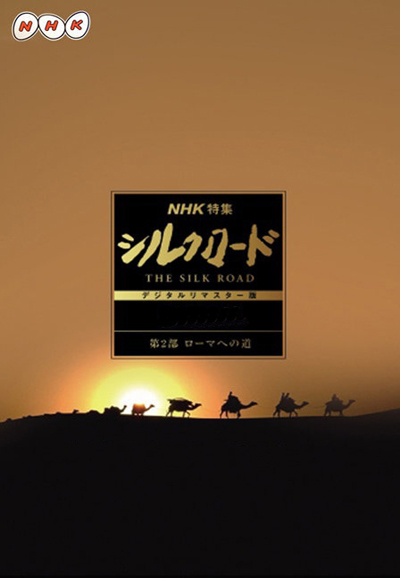
The Silk Road
Non notée
Année : 1980
Nombre de saisons : 4
Durée moyenne d'un épisode : 50 minutes
Genre(s) : Documentaire
For thousands of years, the fabled Silk Road, as travelled by Marco Polo, was the link between the people of Europe and the vast riches of mysterious China. Spanning the deserts, grasslands, and seas between Istanbul and the major cities of China, the Silk Road witnessed an ongoing parade of goods and traders, carrying with them their art, religion, and culture. The impact of the Silk Road is immeasurable - giants such as Alexander the Great and tyrants such as Genghis Khan created our world's history while striding along its path! Now, the Silk Road comes alive, in all its glorious colours, sounds, and historical drama, in an unparalleled documentary achievement. The first co-production of China Central TV and the outside world, this series was ten years in the making, and produced at a cost exceeding 50 million. The entrancing soundtrack made the composer/performer Kitaro a worldwide star, and has sold millions of records to date. Silk Road has been aired to huge critical acclaim in over 25 countries, and remains to this day the highest rated documentary series in Japan's television history.
Saisons

Saison 1

Saison 2

Saison 3

Saison 4
Épisodes
Choisissez votre saison au dessus et découvrez les épisodes qui vous attendent !
Épisode 1 - Glories of Ancient Chang-An
7 avril 1980
In "The Glories of Ancient Chang-An," you'll visit the starting point of the Silk Road. Chang-An, the world's largest city in the seventh century, you'll see the incredibe clay army. Buried for almost 2,000 years, the discovery of these 6,000 statues is an archaeological triumph, and The Silk Road crew were the first foreigners allowed to photograph it. Thrill at the sculptures buried in the world's largest tomb. And then, enter China's most hallowed Buddhist temple, and examine the hidden underground murals of a legendary princess, and walk the only man-made object visible from outer space, The Great Wall of China.
Épisode 2 - A Thousand Kilometers Beyond the Yellow River
5 mai 1980
In "A Thousand Kilometers Beyond the Yellow River," you'll cross the Yellow River in a goat skin raft. Gaze in awe at the same giant Buddha that Marco Polo saw 700 years ago. Look with amazement at the giant water wheels that irrigate miles of Chinese croplands, and visit the secret caves of Bing Lui Si, never before photographed by a television crew. Then, transverse the Forbidden Corridor between the mountains and the Gobi Desert, where the Huns battled the Chinese for control over the most prized horses in the world.
Épisode 3 - The Art Gallery in the Desert
2 juin 1980
In this episode - The Art Gallery in the Desert, the Silk Road crew go to the Gobi Desert and look around the Mogao Caves at Dunhuang. The Mogao Caves consist of over 500 caves, more than 30 miles in length. There are thousands of murals and statues in the caves from 366 AD, encompassing the art styles of Greece, India and the many dynasties of China. These caves hand-tunnelled into the Mingsha Mountains are a tour-deforce of religious art. They exemplify man's striving to create a legacy of his accomplishments and beliefs.
Épisode 4 - The Dark Castle
7 juillet 1980
The Silk Road crew travel to Khara-khoto, 250 miles from the oasis of Jiu-chang, near the Qilian Mountains in the Gobi Desert. Buried by the Gobi sands, the lost city was unearthed by the Russian explorer Koslov, who took its artworks to the Hermitage. A person of Tangut tribe tells a story about the last king of Khara-khoto - Batir. Khara-khoto was rich and prosperous before its ruins by the the Mongol invasion of the thirteenth century. The episode focuses on why and how the ancient city got ruined.
Épisode 5 - In Search of the Kingdom of Lou-Lan
4 août 1980
The journey continues in search of the lost kingdom of Lou-Lan. The Silk Road crew leave Yan-guan for Lou-Lan on the west side of Lake Nop Nur in the Taklamakan Desert, accompanied with Chinese military people. They look around the Lake Lop Nur, which is now dried up and has been vanishing into the sands of the desert. Through sandstorms of the desert, they arrive at the region of the legendary kingdom and find many archaeological objects - coins, Roman beads, written texts, and even mummified bodies.
Épisode 6 - Across the Taklamakan Desert
1 septembre 1980
The Silk Road crew reach Miran discovered by British explorer Aurel Stein, Buddhist city, in southwest part of the Lou-Lan kingdom. Pictures in the mixture of Chinese and western culture are shown. And then they arrive at the oasis town of Cherchen, where they visit a family in Uyghur tribe and see the family's life and economy. And then they try to reach Niya across the Taklamakan Desert by camels. Niya was once a major commercial place on the Silk Road even though the place has been buried for long time into the sands of the desert.
Épisode 7 - Khotan-Oasis of Silk and Jade
6 octobre 1980
This episode tries to introduce local cultures and industries in the region of Khotan, an oasis town in the southwest part of the Taklamakan Desert and largely populated by Uyghurs. It starts with a camel caravan bringing big chunks of jade down from the Kun-Lun Mountains. This Kun-Lun Mountains has been a main place to collect jade in China. Some jade products like a jade armor suit are shown. Through the Silk Road, jade as well as silk were carried: jade to Chan An; silk from Chang An. And then it tells the famous tale of the "Silk Princess" who smuggled silkworms out of China and the silk industry - weaving and spinning, in the region.
Épisode 8 - A Heat Wave Called Turfan
3 novembre 1980
The Silk Road crew explore the hottest region on the Silk Road - Turfan, once called Land of Fire: Mud lake below sea level; people's life in the hot weather - sleeping in open air on roofs; reddish mountains known as Fire Mountains; its local economy - grape harvest and drying grapes; and underground water supply system - Karez. And also they take us on a journey to Gaochang, an ancient oasis town on the Silk Road: ruins of the town; paintings and artifacts showing the cultures of Gaochang.
Épisode 9 - Through the Tian Shan Mountains by Rail
1 décembre 1980
In this episode, the Silk Road crew travel from Turfan to Korla by train - starting in the Gobi region, crossing the eastern Tian Shan and down into the northern Tarim Basin oases. On the way of their journey, they experience how difficult camel travel over the mountain passes would have been for historic Silk Road travelers. And they visit some historical sites on the journey: fortifications built during Tang dynasty; a Mongolian tribe living in high Tian Shan Mountains; and ruins of Buddhist caves at the outskirts of Yanqi (Karashahr), an oasis town on Yanqi plain.
Épisode 10 - Journey into Music-South Through the Tian Shan Mountains
5 janvier 1981
The Silk Road crew reach Kucha, used to be called "Qiuzi". It was a prosperous place and was an ancient Buddhist kingdom. Now Kucha is famous for two things - music and fresh fruits. They find people in Kucha enjoy music and dancing everywhere: farmers sing harvesting crops and processing them; Kucha people enjoy dancing with music after finishing harvest. They try to present why Kucha people enjoy music in everyday life so much with historical evidences. They visit Buddhist caves near Kucha and find paintings and artifacts related to music: a wooden box with paintings of ancient "orchestra" in bright colors; paintings of angels playing musical instruments.
Épisode 11 - Where Horses Fly Like the Wind
2 février 1981
In this episode, the Silk Road crew take a journey along the north Tian Shan route of the Silk Road. They arrive at Hami by train from Xian, and there they take a journey by cars along the north Tian Shan route. On the way, it is narrated, "The north Tian Shan road starts from Hami, passes through Barkol, and crosses the lli River, and ends in Rome". Their journey ends in the border between China and Kazakhstan, just before crossing the lli River. During the journey, they meet Kazakhs, a nomadic tribe, near Lake Barkol. There they experience the ethnic group's culture - wedding ceremony, making cheese using horse's milk, and sports like sheep catching. And then they visit a yearly market opened near Lake Sairam and find ethnic diversity - people are from many different ethnic groups including Uyhurs, Kazakhs and Uzbeks.
Épisode 12 - Two Roads to the Pamirs
2 mars 1981
The Silk Road crew take a journey from Kashgar, via Tashkurgan in the Pamir Plateau, to the border between China and Pakistan on the Karakoram Highway, along the Silk Road route from China to Pakistan. The half of the episode is devoted to people's life in Kashgar including religion and culture. There live many different ethnic groups together in Kashgar such as Uzbeks, Uyhurs, Tajiks and Kyrgyz. Most of them are in Muslim. The Silk Road crew arrive at Kashgar at the end of Ramadan and find thousands of people praying in a mosque and also enjoying the celebration in streets. Then they explore local workshops and craftsman stores - making jewelry, musical instruments, and making pots using metals. And also they see modern truck caravan from Gilgit in Pakistan arrive, and trade: dried fruits and nuts, nylon scarves, medicine etc from Pakistan; silk, ceramics, tea, etc from China. Their journey continues to Tashkurgan in the Pamir Plateau and ends in the border between China and Pakistan on the Karakoram Highway.
Épisode 1 - Across the Pamirs
4 avril 1983
Épisode 2 - The King's Road
2 mai 1983
Épisode 3 - Legendary Ladakh
6 juin 1983
Épisode 4 - The Travels of Xuang Zang in India
4 juillet 1983
Épisode 5 - The Scorching Sun and the Southern Road of Iran
1 août 1983
Épisode 6 - The Desert: In Search of Wisdom
5 septembre 1983
Épisode 7 - Beyond Baghdad
3 octobre 1983
Épisode 8 - The Road Vanished into a Lake
7 novembre 1983
Épisode 9 - Across the Steppes
5 décembre 1983
Épisode 10 - The Sky Horses of Davan
9 janvier 1984
Épisode 11 - The Soghdian Merchants
6 février 1984
Épisode 12 - The Glory of Samarkand
5 mars 1984
Épisode 13 - Across the Karakum Desert
2 avril 1984
Épisode 14 - The Other Silk Road
7 mai 1984
Épisode 15 - The Caravans Move West
4 juin 1984
Épisode 16 - The Horsemen of Turkey
2 juillet 1984
Épisode 17 - The Silk City at the Edge of Asia
20 août 1984
Épisode 18 - All Roads Lead to Rome
3 septembre 1984
Épisode 1 - Departure from the seabed
24 avril 1988
Épisode 2 - Nile / Hot Sand Sea Road
29 mai 1988
Épisode 3 - Happy arabia
26 juin 1988
Épisode 4 - Sailing / Sindbad Ship
31 juillet 1988
Épisode 5 - Adventurer of the cross
28 août 1988
Épisode 6 - Indian pepper coast
2 octobre 1988
Épisode 7 - Buddha and jewels
30 octobre 1988
Épisode 8 - Cross the Golden Chersonese
27 novembre 1988
Épisode 9 - Kingdom of the sea road
25 décembre 1988
Épisode 10 - Chinese gate
29 janvier 1989
Épisode 11 - Junk goes through the city of the sea
26 février 1989
Épisode 12 - Return to Chang'an - The Far Road of the Yangtze River
26 mars 1989
Épisode 1 - The Flame and the Cross: The South Caucasus
31 décembre 2007
Surrounded by 5,000-meter high mountains, the South Caucasus was a strategic point tying together all directions of the Silk Road. Home to 50 ethnic groups, the region is a cultural treasure trove of unique ethnic music, religious architecture, wines, and so on. It has also been invaded by the Roman, Mongol, and Ottoman empires. Wars still rage even now, and over one million people have become refugees. The region is truly representative of both the blessings and the historical calamities brought on by the Silk Road. This leg of the journey will take you to three countries -- Azerbaijan, Armenia, and Georgia -- countries that have long fostered unique cultures tempered by the flames of war.
Épisode 2 - The Progeny of the Queen of Sheba: Yemen and Saudi Arabia
31 décembre 2007
With the end of the civil war, the people of Yemen are now building a new country. The remains of the palace of the Queen of Sheba, or Bilqs, are being excavated as a way of regaining Yemeni ethnic pride. North of Yemen lies the current oil kingdom, Saudi Arabia. Until 50 years ago, half of the Saudi people led nomadic lives. With the sharp rises in oil prices, people in Saudi Arabia gained enormous wealth, and as a result, the historical character of their cities began to change its shape. The tale of rise and fall transcending time and space echoes through the 1,500-kilometer journey across the Arabian Peninsula.
Épisode 3 - Steep Road to the Oasis: Kyrgyzstan and Uzbekistan
31 décembre 2007
Our next destination is the countries in Central Asia. We will visit a new city that has emerged near the border between Kyrgyzstan and China. The city shows rapid growth due to the huge influx of Chinese goods. Heading west, we will see the cotton fields spread out across a huge oasis in Uzbekistan. We also explore the beautiful, white-bricked city of Bukhara, which still maintains an atmosphere of the middle ages. In one of the city's narrow streets, Uzbekis, Russians, Jews, and others live together side-by-side in harmony. Visit these people who live to the fullest amidst the uncertainties after the collapse of the former Soviet Union.
Épisode 4 - From Wasteland to Motherland: Central Asia
31 décembre 2007
From Kazakhstan, this episode cuts through the steppe regions of Central Asia to Russia and the Ukraine. We meet ethnic Kazakhs in China seeking to return to their homeland and displaced Chechens deciding whether to return to their war-torn homeland or stay where it is peaceful. And Cossacks, many of whom are now reviving their proud heritage of military service in Imperial Russia, asserting themselves as bastions of support for the Putin government. As we continue our journey through Central Asia, we listen to the songs and stories of these people who are longing to return to the homelands of their distant memories.
Épisode 5 - Echoes of Distant Prayers: Syria and Lebanon
31 décembre 2007
Syria and Lebanon are the "last 100km" of the Silk Road. This area is also where various religions coexist. Here are found a hidden village where Christianity has been protected for 2,000 years, a temple of the Roman Empire, a Shiite holy city, and Christian Maronites who have continued to treasure the legendary Lebanon cedar. However, this area is also plagued by endless wars. The voices of prayers for peace are heard as we wonder if those of a family who's lost a son amid the confrontations can appease the continuous conflicts.
Vidéos
Oups aucune vidéo pour le moment... Revenez plus tard pour des aventures en images !

Aucun avis pour le momment...